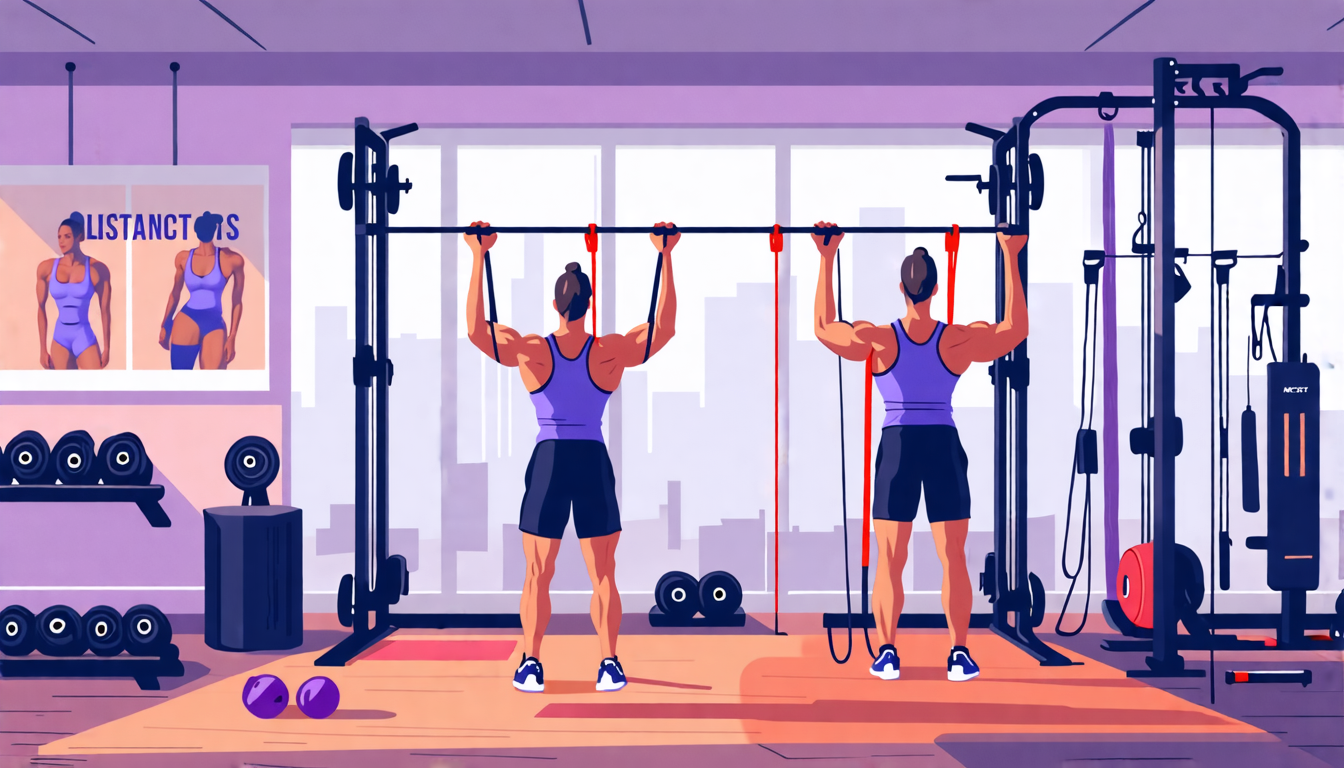When it comes to expanding the capabilities of your home fitness routine, combining a fitness bar with resistance bands is a powerful strategy. This dynamic duo not only enhances workout versatility but also significantly increases muscle activation and strength, allowing you to get more out of each session. Incorporating resistance bands with your fitness bar can transform standard exercises into compound movements, offering a comprehensive workout that targets multiple muscle groups simultaneously. Whether you’re looking to improve your strength, boost endurance, or simply add variety to your fitness regimen, using resistance bands with your fitness bar provides endless possibilities. In this article, we’ll explore the myriad benefits of this combination, provide a step-by-step guide on how to select and set up the right resistance bands, and outline some highly effective exercises you can perform to maximize your results. By the end, you’ll have all the knowledge you need to elevate your home fitness bar routine to new heights.
Benefits of Incorporating Resistance Bands with a Fitness Bar
Enhance Workout Versatility
Adding resistance bands to your fitness bar opens up a wide range of possibilities for achieving a comprehensive and varied workout. With resistance bands, traditional bar exercises can be transformed and diversified, catering to multiple fitness levels and goals. For instance, moves like squats, deadlifts, and bench presses can be made more challenging or accessible, depending on the resistance band’s thickness and resistance level.
Resistance bands introduce variable resistance, where the tension increases throughout the range of motion. This means that as you extend the band further, the resistance becomes greater, making your muscles work harder at the peak of the exercise. This is particularly beneficial for individuals who want to maintain consistent muscle engagement throughout their workouts. Moreover, as resistance bands don’t rely on gravity, they can provide resistance in different directions, thus enabling exercises that would otherwise be impossible with just the fitness bar alone.
Owning a variety of resistance bands offers an ever-expanding exercise library. You can seamlessly switch between exercises that target different muscle groups, effectively turning your home gym into a more versatile training space. With resistance bands, you can easily transition from strength training to stretching, mobility work, or even warm-up and cool-down routines, all while using a single fitness bar setup. This adaptability can help prevent workout monotony and keep you motivated.
Increase Muscle Activation and Strength
Incorporating resistance bands with your fitness bar can lead to enhanced muscle activation, which is crucial for improving overall strength and hypertrophy. Resistance bands provide continuous tension throughout the entirety of the movement. This continuous tension not only engages more muscle fibers, leading to greater activation, but also supports balanced muscle development, addressing both the concentric and eccentric phases of exercise.
Enhanced muscle activation translates to greater muscle recruitment. When banded resistance is added to a barbell, your stabilizer muscles are forced to adapt and engage in order to maintain control and balance throughout the movement. This adaptation is crucial for improving muscular coordination and functional strength, as you’ll be working multiple muscle groups simultaneously. For example, during a banded squat, both your legs and your core are activated to stabilize the movement, resulting in a more efficient and effective workout.
Moreover, the progressive nature of resistance bands means that as your strength increases, you can gradually use bands with higher tension levels to continually challenge your muscles. This helps in breaking through plateaus and ensuring consistent muscle growth and strength gains. When paired with a fitness bar, resistance bands can be particularly effective in targeting and isolating specific muscles that may otherwise be difficult to engage fully with traditional weights alone.
Studies have shown that the use of resistance bands in strength training programs can yield comparable, if not superior, results to traditional free weights, making them an excellent addition to any home fitness regimen. The added resistance provided by the bands complements the inherent benefits of the fitness bar, offering a comprehensive tool for those looking to enhance muscle activation, build strength, and improve overall fitness.

Step-by-Step Guide to Using Resistance Bands with a Fitness Bar
Selecting the Right Resistance Bands
Choosing the appropriate resistance bands is crucial for maximizing your fitness bar workouts. Resistance bands come in various levels of resistance, usually indicated by colors. Light bands are perfect for beginners and for exercises requiring less tension, while medium and heavy bands are suited for those seeking a more challenging workout.
Consider the following factors when selecting resistance bands:
- Band Material: High-quality latex or fabric bands are durable and can withstand intense workouts. They are less likely to snap or degrade over time.
- Resistance Level: Beginners should start with lighter resistance and gradually progress to medium or heavy bands as they build strength and endurance.
- Length and Thickness: Ensure that the bands are long enough to accommodate your fitness bar and the exercises you’ll be performing. Thicker bands usually provide greater resistance.
Making the right choice in resistance bands will set the foundation for effective workouts and prevent potential injuries.
Setting Up and Attaching the Bands
Proper setup is vital for ensuring safety and effectiveness when using resistance bands with a fitness bar. Follow these steps to correctly set up and attach your resistance bands:
- Inspect the Bands: Before each workout, check the bands for any signs of wear and tear. Discard and replace any bands that appear damaged.
- Anchor Points: Secure the bands to stable anchor points such as heavy furniture, door anchors, or specifically designed anchoring systems. Ensure the anchor points can withstand the tension exerted during your workouts.
- Attach to the Bar: Loop the bands around the ends of the fitness bar. Ensure they are evenly distributed to avoid imbalances and potential accidents. You can tie a knot or use specialized clips to secure the bands onto the bar firmly.
- Test the Setup: Gently pull on the bands and the bar to ensure everything is secure before beginning your workout. Feel for any potential slippage or instability and adjust accordingly.
Following these steps will help you create a safe and effective workout environment, reducing the risk of injury and enhancing your overall fitness experience.
Effective Exercises to Perform
Incorporating resistance bands with your fitness bar can significantly enhance the effectiveness of various exercises. Here are some effective exercises you can perform:
Banded Squats
Adding resistance bands to squats increases muscle activation in your legs and glutes. Here’s how to do it:
- Place the resistance band under your feet and hold the fitness bar across your shoulders.
- Perform a squat by bending your knees and lowering your hips while keeping your chest up and back straight.
- Engage your glutes and quadriceps as you push back up to the starting position.
Banded Deadlifts
This exercise targets your hamstrings, glutes, and lower back. Follow these steps:
- With the resistance band under your feet, grasp the fitness bar with an overhand grip.
- Hinge at your hips, lowering the bar while keeping your back straight and chest up.
- Engage your glutes and hamstrings to return to the starting position, extending your hips fully at the top.
Banded Shoulder Press
This exercise strengthens your shoulders and upper body. Here’s how to do it:
- Stand on the resistance band with feet shoulder-width apart, holding the fitness bar at shoulder height.
- Press the bar overhead until your arms are fully extended, keeping your core engaged.
- Lower the bar back to shoulder height with control, making sure not to flare your elbows.
Banded Bent Over Rows
Targeting your upper back and lats, this exercise is essential for a strong back. Follow these steps:
- Stand on the resistance band and hold the fitness bar with an overhand grip, bending at your hips and knees.
- Pull the bar towards your lower chest or upper abdomen, squeezing your shoulder blades together.
- Lower the bar back to the starting position with control.
Banded Chest Press
This exercise is excellent for building chest strength. Here’s how to do it:
- Secure the resistance band to a sturdy anchor point behind you and hold the fitness bar at chest level.
- Push the bar away from your body until your arms are fully extended, keeping your core tight.
- Slowly return the bar to the starting position, maintaining tension in the band.
Incorporating these exercises into your routine will exploit the advantages of resistance bands and a fitness bar, providing a comprehensive and challenging workout. Adjust the resistance to match your fitness level and progressively increase the intensity as you become more comfortable with the movements.
Incorporating resistance bands with your fitness bar can significantly elevate your home workout routine by enhancing versatility and increasing muscle activation and strength. By integrating these bands, you open up a realm of exercise options that cater to various fitness levels and target multiple muscle groups. The dynamic tension provided by resistance bands recruits more muscle fibers and challenges your muscles through different angles of resistance, which is crucial for achieving better strength and hypertrophy.
The process of adding resistance bands to your fitness bar starts with selecting the appropriate bands. Consider the resistance level that aligns with your fitness goals and current strength. Proper setup is equally essential, as securely attaching the bands to the bar and anchoring points ensures safety and effectiveness. Begin by wrapping the bands around the ends of the fitness bar or using specific attachments designed for this purpose. Once set up, a variety of exercises, such as squats, deadlifts, bench presses, and rows, can be performed with added resistance to optimize muscle engagement.
This simple yet effective modification can transform a traditional fitness bar into a versatile piece of equipment suitable for a comprehensive workout regimen at home. By leveraging the strengths of resistance bands, you can overcome plateaus, introduce progressive overload in a controlled manner, and enjoy the benefits of functional training. Whether you’re a beginner or an advanced fitness enthusiast, this method offers an adaptable solution for continuous improvement and an enhanced home fitness experience.

